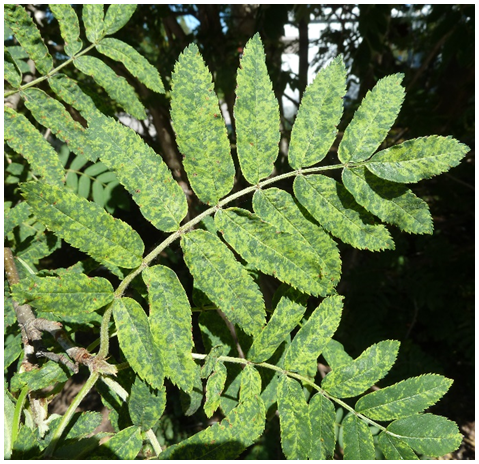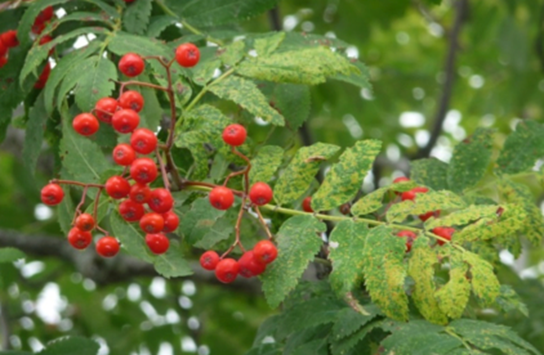Section outline
-
-
-
Urban pest & disease
Ringspot disease of rowan and other Sorbus species
Pathogen
European mountain ash ringspot-associated virus (EMARaV), Emaravirus sorbi
-
-
-
Chlorotic ringspot and line patterns on leaves, leaf mottle, deformation of the leaf blade, sometimes with dieback of twigs and branches leading to sparse canopy and slow decline of infected trees as well as minimal fruit set. Examples of symptoms in different Sorbus species see below.



EMARaV-infected rowan (S. aucuparia) exhibiting mottle (above left) and chlorotic ringspots (above right) on leaves and leaf deformation and poor fruit set (below).
-
-
-
EMARaV is widespread in Europe, infecting Sorbus aucuparia (European mountain ash, syn. rowan) and inducing chlorotic ringspots, mottle and line pattern on leaves. The virus has been experimentally transmitted by grafting to other Sorbus spp. and to members of the related genera Sorbaronia, Aronia and Amelanchier (Führling and Büttner 1995, Grimova et al. 2015). Graft-inoculated members of the subfamily Maloideae (Amelanchier, Aronia, several different Sorbus spp.) develop symptoms typical of an EMARaV infection. The virus is considered to be naturally transmissible by the eriophyid gall mite Phytoptus pyri (Pagenstecher, syn. Eriophyes pyri, pear leaf blister mite), (Mielke-Ehret et al. 2010), while it can be transmitted mechanically only with difficulty to experimental host plants. It can be detected by virus-specific RT-PCR in Nicotiana rustica and N. benthamiana after rub inoculation of EMARaV-infected Sorbus aucuparia but usually induce no symptoms in these indicator plants and do not establish a stable infection that can be maintained over several virus-passages in these hosts. In other fruit tree species of the family Rosaceae, which are related to rowan, such as Malus domestica and Pyrus communis. the virus has been reported to cause latent infections after successful graft-transmission (Grimova et al. 2015).

EMARaV-infected White-fruited Chinese rowan (S. koehneana) exhibiting chlorotic spots and line pattern.
-
-
-
European mountain ash (syn. rowan, Sorbus aucuparia), Karpatiosorbus x hybrida (Sorbus rotundifolia), Swedish whitebeam (S. intermedia), Common whitebeam (S. aria), wild service tree (S. torminalis), White-fruited Chinese rowan (S. koehneana), serviceberries (Amelanchier spicata, A. alnifolia, A. lamarckii, A. ovalis), Aronia melanocarpa, Sorbaronia sp., (English Hawthorn (Crataegus laevigata), pear (Pyris communis), apple (Malus domestica), Japanese rowan (Sorbus commixta), service tree (Sorbus domestica), Bastard service tree (Sorbus x thuringiaca cv. Fastigiata).

EMARaV-infected Swedish whitebeam (S. intermedia) expressing above: chlorotic spot, below: mottle (left) and ringspots on leaves (right).
-
-
-
The use of tested virus-free plant material especially when using S. aucuparia as rootstock in nursery propagated species of the Maloidea-subfamily is highly recommended. Reliable diagnosis of EMARaV can be done by molecular tools such as virus-specific RT-PCR or RT-PCR using genus-specific primers in combination with Sanger-sequencing (Rehanek et al. 2022). Commercial serological tests are not available yet. EMARaV-infected host plants in urban environments should be cultivated under optimal environmental conditions to keep their vitality. If that is not possible the infected tree has eventually to be removed, if it shows ongoing decline symptoms. This decision depends on the trees function and epidemiological risk to infect further host species.

EMARaV-infected common whitebeam (S. aria) with chlorotic line pattern and spots.
-
-
-
Not regulated within the EU
-
-
-
Europe-wide distribution (Austria, Denmark, Estonia, Finland, Germany, Norway, Sweden, Russia, The Czech Republic, The Netherlands, United Kingdom)
-
-
-
EMARaV (genus Emaravirus, family Fimoviridae) is a single stranded RNA virus with a negative orientation (Rehanek et al. 2022). The virus genome consists of six RNAs (von Bargen et al. 2019) which are encapsidated by the virus-encoded nucleoprotein. The nucleocapsids are protected by a lipid-double membrane with integrated glycoproteins, thus forming the spherical particles of varying size (80-100 nm). Due to its molecular and morphological characteristics EMARaV, was the first member of the newly established genus Emaravirus.
Although the ringspot disease of rowan was already first described in 1957 in Finland (Jamalainen 1957) and the virus has been identified as causal agent in 2007 (Mielke & Mühlbach, 2007) several questions regarding the epidemiology of EMARaV need further research. The host range as well as the modes of transmission for instance (by pollen and seed, vector species involved, water, root connation etc.) has to be investigated, in order to explain the part of vector- and seed-, water- and soil transmission in the wide geographical distribution of the ringspot disease of rowan as well as the impact of the virus on the vitality of virus-infected trees.

EMARaV-infected bastard serviceberry (Karpatiosorbus x hybrida, syn. S. rotundifolia) showing chlorotic line pattern, spots, and mottle.
-
-
-
1. Führling, M., Büttner, C., 1995 Transmission Experiments of Viruses to Woody Seedlings (Quercus robur and Sorbus aucuparia) by Grafting and Mechanical Inoculation. Eur. J. For. Path. 25, 129–135.
2. Grimová L, Marek M, Konrady M, Ryšánek P, 2015. Newly identified host range of European mountain ash ringspot-associated virus (EMARaV) and its distribution in the Czech Republic. Forest Pathology 45, 177-189. http://dx.doi.org/10.1111/efp.12151
3. Jamalainen, E.A., 1957. On plant virus diseases and virus-like diseases in Finland. Publications of the Finnish State Agricultural Researc,h Board No. 158. Tikkurila, Finland: Agricultural Research Centre.
4. Mielke-Ehret, N. and Mühlbach, H.P., 2012. Emaravirus: A novel Genus of Multipartite, Negative Strand RNA Plant Viruses. Viruses, 4, 1515–1536, doi:10.3390/v4091515
5. Mielke-Ehret, N., Thoma, J., Schlatermund, N., Mühlbach, H.P., 2010. Detection of European Mountain Ash Ringspot-Associated Virus-Specific RNA and Protein P3 in the Pear Leaf Blister Mite Phytoptus Pyri (Eriophyidae). Arch. Virol., 155, 987–991, doi:10.1007/s00705-010-0667-3
6. Rehanek, M., Karlin, D.G., Bandte, M., Al Kubrusli, R., Nourinejhad Zarghani S., Candresse, T., Büttner C, von Bargen, S., 2022. The Complex World of Emaraviruses—Challenges, Insights and Prospects. Forests 13, 1868. https://doi.org/10.3390/f13111868
7. Rehanek, M., Al Kubrusli, R., Köpke, K.; von Bargen, S., Büttner, C., 2024.
Detection of viruses in special stands of common ash reveals insights into the virome of
Fraxinus excelsior. Forests. https://doi.org/10.3390/f150813798. Robel, J., Dieckmann, L., von Bargen, S., Büttner C., 2013. First detection of European mountain ash ringspot associated virus in rowan trees in Scotland. New Disease Reports 27, 13. http://dx.doi.org/10.5197/j.2044-0588.2013.027.013
9. Rumbou, A., Vainio, E.J., Büttner, C., 2021. Towards the Forest Virome: High-Throughput Sequencing Drastically Expands Our Understanding on Virosphere in Temperate Forest Ecosystems. Microorganisms, 9, 1730. https://doi.org/10.3390/microorganisms9081730
10. Vainio, E.J., Rumbou, A., Diez, J.J., Büttner, C., 2024. Forest Tree Virome as a Source of Tree Diseases and Biological Control Agents. Curr. For. Rep. 10, 153–174. https://doi.org/10.1007/s40725-024-00214-8
11. von Bargen, S., Arndt, N., Robel, J., Jalkanen, R., Büttner C., 2013. Detection and genetic variability of European mountain ash ringspot-associated virus (EMARaV) in Sweden. Forest Pathology 43, 429-432.
12. von Bargen, S., Büttner, T., Mühlbach, H-P., Robel, J., Büttner, C., 2014. First report of European mountain ash ringspot-associated virus in Sorbus aucuparia in Norway. Plant Disease 98, 700.
13. von Bargen, S., Tischendorf, M., Büttner C., 2018. First report of European mountain ash ringspot-associated virus in serviceberry (Amelanchier spp.) in Germany, New Disease Reports 37, 19. http://dx.doi.org/10.5197/j.2044-0588.2018.037.019
14. von Bargen S, Dieckmann HL, Candresse T, Mühlbach HP, Roßbach J, Büttner C, 2019. Determination of the complete genome of European mountain ash ringspot-associated emaravirus from Sorbus intermedia reveals two additional genome segments. Archives of Virology 164, 1937-1941. http://dx.doi.org/10.1007/s00705-019-04275-0
-
-

